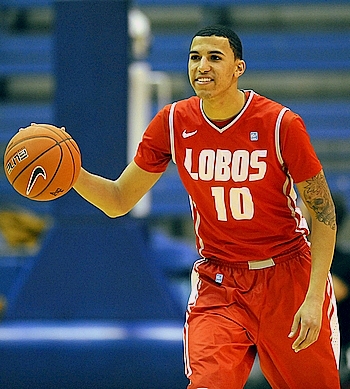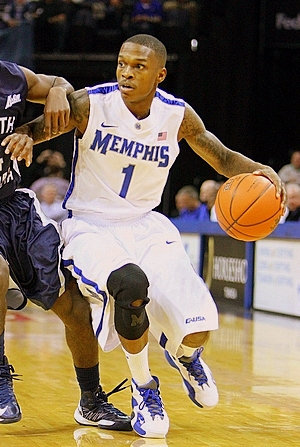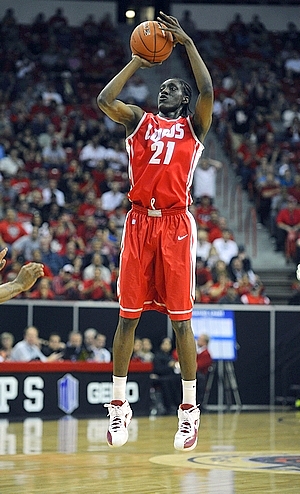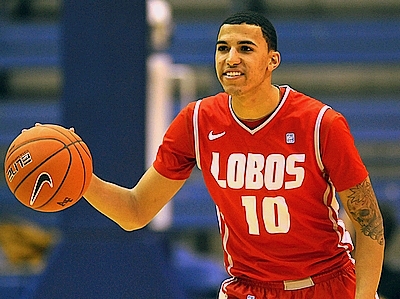Incoming freshmen have been excluded from these previews, as we'd like to wait and see what they have to offer on the NCAA level before we come to any long-term conclusions.
The Top 101 Prospects in the BCS Conferences
-Top 20 NBA Prospects in the Big Ten
-Top 20 NBA Prospects in the ACC
-Top 11 NBA Prospects in the Big XII
-Top 15 NBA Prospects in the Pac-12
-Top 20 NBA Prospects in the Big East
-Top 15 NBA Prospects in the SEC
-Top NBA Prospects in the Non-BCS Conferences, Part One
(#1) Tony Mitchell Video Scouting Report
-Top NBA Prospects in the Non-BCS Conferences, Part Two
(#2) C.J. McCollum
(#3) Jamaal Franklin
(#4) Adonis Thomas
(#5) Mike Moser
-Top NBA Prospects in the Non-BCS Conferences, Part Three
(#6) Doug McDermott Video Scouting Report
-Top NBA Prospects in the Non-BCS Conferences, Part Four
(#7) Ray McCallum
(#8) Alec Brown
(#9) Nate Wolters
(#10) Isaiah Canaan
-Top NBA Prospects in the Non-BCS Conferences, Part Five
(#11) Jackie Carmichael
(#12) Tarik Black
(#13) Robert Covington
(#14) Mike Muscala
(#15) Deonte Burton
#16, Kendall Williams, 6-4, Junior, Point Guard, New Mexico

Jonathan Givony
Kendall Williams was deemed a major prospect very early on in his high school career, being offered a scholarship from hometown UCLA already after his freshman year. He accepted that scholarship and remained committed for much of high school, but saw his stock drop significantly in the eyes of the recruiting services and ended up parting ways with UCLA when he realized the interest in him had cooled significantly.
Williams ended up at New Mexico, where he became an instant contributor, playing 30 minutes per game in each of his first seasons and developing into an All-Conference player as a sophomore after winning freshman of the year honors. Now a junior, he'll be expected to take the next step as a collegiate and pro prospect as one of the leaders of a team off to an outstanding 4-0 start to the 2012-2013 campaign, with wins over Davidson, George Mason and UConn.
Williams has excellent size for a point guard at 6-4, with a wiry frame that still needs to fill out. He's a good athlete on top of that, showing outstanding speed in the open court, and the ability to make plays above the rim.
Williams shows a very good feel for running an offense and getting teammates involved, as he's an unselfish player with a high basketball IQ. His size allows him to see over the top of opponents, and he shows very nice timing drawing defenders and then making the extra pass to cutters at the rim or shooters spotting up outside, playing at a very unique pace.
New Mexico's primary ball-handler in isolation and pick and roll situations, Williams is still figuring out how to blend his scoring and passing game efficiently at this stage. He struggled to finish at a high rate around the basket in the half-court last season, making just 21 of 55 attempts. Not possessing the most explosive first step around, he can still stand to improve upon his advanced ball-handling skills and ability to change speeds and get all the way to the rim, as he tends to take a lot of tough-angled layups from just outside the paint or floaters from 5-7 feet out. Getting stronger and better at finishing with his left hand will help here, but he showed decent flashes in this area at times last season, particularly in his ability to get to the free throw line.
Williams has been a solid shooter since he stepped on campus, making 43% of his 3-point attempts as a freshman and then 36% last year. He doesn't possess the most conventional mechanics, but he's a confident and proficient shot-maker who is capable of hitting with his feet set or off the dribble, and has already made a number of very important shots for New Mexico late in games. This allows him to see some minutes playing off the ball as well in different lineups and half-court sets, which gives his team some added versatility. It will be interesting to see how he shoots the ball this season now that he'll likely be asked to carry a heavier scoring load.
On the other end of the floor, Williams is a very capable option as well. He puts a very good effort in defensively, doing a good job getting in a low stance and working hard to keep opponents out of the lane and contest shots with his length. His excellent size gives him the ability to guard multiple positions, and that coupled with his strong anticipation skills and aggressiveness allows him to get in the passing lanes on a regular basis. While perhaps not the quickest player laterally, or the strongest fighting over screens, Williams' size, high basketball IQ, competitiveness are major assets.
A fairly unconventional player, Williams has some very interesting strengths to build on with his excellent size and playmaking skills. After losing one of the best players in the conference in Drew Gordon, the Lobos will likely need Kendall Williams (and teammate Tony Snell) to have a big year if they are to make the NCAA Tournament once again, which should help him gain more notoriety on the national level and draw some more attention from NBA decision makers. Based on what we've seen in the early going, Williams is poised to have a breakout season.
#17, Joe Jackson, 6-0, Point Guard, Junior, Memphis

Joe Treutlein
After two shaky seasons to start his collegiate career, and rumors of a possible transfer midway through his sophomore campaign, Joe Jackson is looking to live up to his considerable high school accolades as a junior.
Standing 6'0 ½ with a solid 6'3 wingspan and top tier quickness and explosiveness, Joe Jackson is an outstanding athlete in many aspects, but is still held back by his very thin frame and lack of strength. While the 20-year-old could still get stronger and even add some mass to his body, he's likely always going to be on the frail side by NBA standards, something he'll need to overcome with his other attributes.
Jackson struggled badly as a freshman, and was unable to effectively run the offense for Team USA in the U-19 World Championships in 2011, though he did manage to take some subtle strides forward his sophomore season. While his strengths and weaknesses on the floor remain the same, he saw his free throw rate, assist rate, and scoring efficiency all tick slightly upwards last year as he better adjusted to the NCAA game. Most significant was the fact that he was able to bring his meteoric turnover rate from an impossible 5.7 turnovers per-40 minutes as a freshman to a much more manageable 3.5 per-40 as a sophomore.
On the offensive end, Jackson is a score-first point guard most comfortable pushing the ball in transition, a style he's played for most of his life. He shows solid instincts and passing ability in these situations, and is even more capable using his creativity and leaping ability to finish around the basket on a well-spaced court. He has no problem weaving through defenders when he's on the move by using his excellent speed and ball-handling abilities either.
In half-court situations, however, things are much murkier, where he doesn't show the steady game-management you'd expect from a high-level point guard. While Jackson is certainly capable of wowing onlookers using his blazing first step to get to the basket out of isolations and pick-and-rolls, or using his ball-handling to get separation for a pull-up mid-range jumper, he's just as likely to turn over the ball over-penetrating, over-dribble the ball, or badly miss an outside shot.
Jackson clearly has a great deal of talent, but he's struggled to find a way to consistently balance all of these things in a half court setting. Further, his outside shot is plagued by inconsistent mechanics and just as inconsistent results that show up both in pull-up and catch-and-shoot situations. His ability to break down the defense and finish around the basket, while much more clearly a strength at this level, is also a concern projecting forward given his physical stature. He already shows some problems finishing in traffic in the lane in college, something that could become even more problematic against bigger, more athletic pros.
Looking towards his junior season, Jackson can do many things to help his game, with cleaning up his perimeter shot and becoming a more consistent threat spotting up and off-the-dribble would certainly go a long way. Becoming a steadier floor general, ideally by putting his speed and versatility to use with a more featured pick-and-roll game would also help, but that's not necessarily up to him to decide. He already sees a staggering 30.8% of his possessions in transition according to Synergy Sports Technology, so it's probably not feasible for him to play a much faster style of play, and finally improving his half-court decision making is critical.
On the bright side, one area he has managed to excel at the collegiate level is on the defensive end of the floor, where he's done a much better job utilizing his strengths and adapting to his shortcomings. Jackson really came into his own last season in this regard, playing very aggressively in perimeter defense by using his speed and length to blanket his opposition on the ball. He shows a good fundamental stance, excellent lateral quickness, and a willingness to move his feet and contest shots well, to the point where being shot over was barely ever an issue. This may change against taller competition in the pros, and his slight struggles getting over screen-and-rolls could become more of an issue as well, but he clearly has the tools to be a very good overall defender at the point guard spot, especially in the quickness-oriented NBA that has evolved in the past few years.
Looking forward, Jackson has a lot of work to do his last one or two years on campus, but has many things going for him projecting ahead. His exceptional quickness and athletic abilities both fit many NBA teams better stylistically than the collegiate game, and it's true on both sides of the floor. He also made some strides with his game as a sophomore, and has a talent level that far surpasses his college resume to date, which leaves plenty of room to take his game upward. For Jackson, becoming more consistent and comfortable in all aspects of his half-court offense needs to be his focus, and it will likely determine whether he can find a long-term niche in the NBA.
#18, Tony Snell, 6'7, Junior, SF, New Mexico

Derek Bodner
After a relatively nondescript freshman campaign, Tony Snell became a key part of New Mexico's rotation as a sophomore. Snell saw his minutes (from 17.5 minutes per game to 25.6), scoring (4.4 points per game to 10.5) and efficiency (51% true shooting percentage to 61%) all take significant jumps during his second season in Albuquerque.
Standing 6'7" with long arms, Snell has good size and length a small forward, although at just 200 pounds he could stand to add bulk in order to defend his position at the NBA level.
At this stage of Snell's career, he is mostly a catch and shoot player on the offensive end. According to Synergy Sports Technology, over 76% of Snell's offense came out of catch and shoot situations, a role at which he excels. Snell has excellent form on his release, with a high release point, excellent follow through, and great balance on his jump shots, and he does a very good job of being in position to receive the pass and get the shot off quickly.
New Mexico coach Steve Alford runs a 2-out-3-in motion offense, which is able to generate a lot of open looks for three point shooters stationed in the corners, a system which does a wonderful job of taking advantage of Snell's proficiency as a catch and shoot player. Snell shot 48.2% on open catch and shoot jump shots last season, which was in the 86th percentile according to Synergy Sports.
Not just a stand still catch and shoot player, Snell got much more of his offense running off of screens to free himself up for open looks, up to nearly 24% of his offense (from under 8%). Snell's footwork looks much improved in this regard, and he is able to gather himself quickly for a jump shot attempt when coming off of baseline screens and curls.
Snell isn't quite as proficient when shooting with a hand in his face, with his field goal percentage dropping to 31.6% when guarded, which is right about average. This could be somewhat alleviated if he were more assertive in establishing an in-between game, as defenders are able to close out aggressively on him due to the limited threat he provides off the dribble. While Snell has shown some ability to shoot off the dribble, that has so far been used so infrequently that it is not something defenders game plan against.
Snell's limited contribution off the dribble is a combination of New Mexico's offense, Snell's average ball handling skills, and a penchant for settling for outside jump shots too frequently. Snell has decent quickness, and he shows some ability as a ball-handler, including a crossover that he is reasonably good with, but he can get loose with his dribble in traffic and overall doesn't seem to trust it very much. One advantage Snell does have is he appears to be more comfortable driving to his left, giving him an advantage over defenders who will instinctively overplay his right hand, since he is a right handed player.
Developing his ball handling and gaining confidence in using one or two dribbles for a pull-up jump shot or a floater in the lane is a key for Snell going forward, as his catch and shoot ability opens up considerable driving lanes for him. If defenders have to give pause before closing out on him it will also give him that split second he needs to get more quality catch and shoot attempts up.
One area where Snell might have some untapped potential is as a passer. Snell's 3.7 assists per 40 minutes pace adjusted is a very good mark for a small forward overall, and especially when taken into the context of how relatively little Snell handled the basketball. Some of that is due to Alford's scheme, as it requires everybody be able to move the basketball, but overall Snell shows solid court vision, even if the execution of his passes aren't always up to the same level. Should Snell improve his ball handling and be able to get into the lane with more regularity, this could be an area of his game where we might see improvement.
At only 200 pounds, Snell would need to add significant strength to be able to defend small forwards, and even many shooting guards, at the NBA level. He can get taken advantage of by bigger guards and forwards already at the collegiate level, and this will only become more pronounced against some of the bruising wing scorers in the NBA.
Snell is also a very anemic rebounder, particularly on the defensive end of the court. Snell averaged only 3.7 defensive rebounds per 40 minutes pace adjusted, which ranks towards the bottom of our database for small forward prospects. While adding some strength to his frame would help, Snell does not appear to be an overly instinctive rebounder, nor does he seem all that willing to fight for rebounds down low. With the loss of Drew Gordon to graduation, this is an area where New Mexico might need to rely on Snell more than they previously did.
That being said, Snell does have some tools to work with on the defensive end. He moves his feet well defensively, which combined with his length gives him ability to contain his man off the dribble. He does a fair job of fighting through pick and rolls, and he does a pretty good job of tracking his man off the ball and fighting through screens. Perhaps most importantly, Snell seems to give solid and consistent effort on this end of the court,
Snell has one definite NBA level skill in his ability to be a catch and shoot threat, which with his size and athleticism will keep him on the radar as a draft prospect. If Snell could add some weight to his frame and show more ability off the dribble and on pull-up jump shots, he could be seen as a potential role player at the next level. It will be interesting how Snell, and the New Mexico offense in general, is able to replace the loss of Drew Gordon, who was responsible for much of the post-up offense Steve Alford's offensive scheme utilizes.
Perhaps more important than any skill set Snell would need to show is an improvement in consistency. Far too often Snell would appear invisible during large stretches of a game, seemingly happy to relegate himself to standing in the corner and taking whatever opportunities came his way. So far through four games this season, Snell has started off his 2012-2013 campaign on the right foot, as he set a career high with 25 points against Davidson on opening night then bested that with 27 against George Mason two games later, getting to the line a combined 19 times in those three games. If Snell maintains that kind of mentality, he could improving his standing considerably amongst NBA decision makers.
#19, Elias Harris, 6-8, Power Forward, Senior, Gonzaga
Having profiled Harris during the 2011-2012 season with a comprehensive scouting report, we've elected to wait and see what type of progress he's made with a fresh perspective in a few months, rather than rehashing many of the same comments made last year based off last year's game footage.
#20, Javon McCrea, 6-7, Power Forward, Junior, Buffalo
Having had a similar season to the one we profiled in last year's preview, we've elected to wait and see what type of progress McCrea has made with a fresh perspective in a few months, rather than rehashing many of the same comments made last year based off last year's game footage.



































Comments